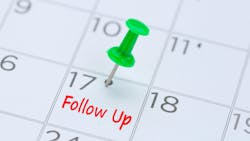Follow-up: It is often the difference maker that defines elite sales pros
I have been spending some time recently working on various projects with a consultant named Gil Cargill. He is the guy who put on a standing-room-only presentation at the NAMA show in May. People were stacked up in the hallway trying to hear him speak. The topic was about using artificial intelligence for lead generation. Gil has been around for a while, and he is the closest thing to a sales guru that I have met along the way.
One of the things we have been talking about is follow-up strategies — and the importance of them. Gil and I both agree that follow-up is something lacking in sales today. It is not a new issue; it has always been the case.
How bad is it?
A little online research will convince you that follow-up skills are even worse than you think. According to the National Sales Executives Association (NSEA):
- 48% of salespeople never follow-up with a prospect.
- 25% of salespeople make a second contact and stop.
- 12% of salespeople make three contacts and stop.
These statistics have been seen on LinkedIn, Facebook and built into sales materials from experts and even well-known keynote speakers.
The problem is, the NSEA does not exist, and these stats are bogus.
While it is safe to say that you should not believe everything you read on the internet, I would be willing to wager that those stats, if cut in half, would be pretty accurate.
For anyone selling convenience services, “follow-up” is an important term. It can refer to at least four different activities and scenarios. This month in the Best of OCS, I will explore two situations that require follow-up, and I will look at a third follow-up scenario in September. Over time, I will get to all four and take a deep dive into follow-up strategies.
Scenario 1: Keeping a prospect engaged
How did this happen? You successfully engaged with the prospect. Then, after getting shot down by the prospect, you did the right thing: You asked the question, “When would be a good time to follow up with you to see if your situation has changed?”
You received an answer, maybe “three months” or “six months” and now, the next time you reach out to that prospect, it will not be a cold call. You are calling back at the time because they asked you to call back in three months or six months.
So here you are, three or six months later, following their instructions, trying to cash in on a little gem in your sales pipeline. This opportunity never happens unless you are organized enough to know that it is time to follow up, so hopefully, your company provides some sales organizational software.
A slight edge, or a favorable twist
You can now confidently call, ask for the prospect by name and inform the gatekeeper that he asked you to give him a call this week. This process has opened the door a little more for you, giving you an increased edge.
When you get the prospect on the phone, you need to remind them, “When we spoke back in July, I’m sure you remember that you were interested in our program but asked me to call back in 90 days so that we can set up a meeting. I have 2 p.m. on Tuesday or Wednesday next week. Which is better for you?”
Here is a twist. Suppose the prospect you spoke to three months ago is no longer working at the company. This creates an even warmer opportunity when you speak to their replacement.
“I understand that you replaced Juan as the office manager. The last time I spoke to Juan, he had asked me to call him to schedule an appointment this week. I know a lot of people at your company liked the idea that we could improve your pantry service program and save you money. I have 2 p.m. on Tuesday or Wednesday next week. Which is better for you?”
Juan’s replacement may want to see you now or may want to see you in three months. If they put you off, the follow-up snowball continues, but when a sales rep has 50 of these scenarios cooking, appointments will happen.
Scenario 2: The call in
Make a connection with every hot prospect or warm lead from any source.
Because there is a cost to every sales lead, follow-up needs to occur ASAP. Your company deserves the maximum effort by sales reps to close deals that are generated through paid business development. Additionally, as a sales rep, you want to encourage the continuation of paid business development – so don’t let a lead like this go to waste.
Top performers stay connected all the time. That includes nights, days off and even vacations. All the relaxation gained during a break will vanish when a sales rep learns that a deal was lost because they were disconnected.
Listen first
Once you qualify the account, the objective is to set up a meeting. When you speak to this warm prospect, gain an understanding of the opportunity and what they need, but don’t do too much selling over the phone or by email. Be an active listener. Too much selling at this pre-meeting stage can raise new and unnecessary objections from the prospect. Don’t kill the deal before it takes shape!
About the Author

Bob Tullio
Bob Tullio is a content specialist, speaker, sales trainer, consultant and contributing editor of Automatic Merchandiser and VendingMarketWatch.com. He advises entrepreneurs on how to build a successful business from the ground up. He specializes in helping suppliers connect with operators in the convenience services industry — coffee service, vending, micro markets and pantry service specifically. He can be reached at 818-261-1758 and [email protected]. Tullio welcomes your feedback.
Subscribe to Automatic Merchandiser’s new podcast, Vending & OCS Nation, which Tullio hosts. Each episode is designed to make your business more profitable.

